Spatiotemporal Variability of Drought and Its Multi-Scale Linkages with Climate Indices in the Huaihe River Basin, Central China and East China
Abstract
:1. Introduction
2. Materials and Methods
2.1. Study Area
2.2. Data
2.3. Methodology
2.3.1. Standardized Precipitation Index (SPI)
2.3.2. Empirical Orthogonal Function (EOF)
2.3.3. Continuous Wavelet Transform (CWT)
2.3.4. Cross Wavelet Transform (XWT)
2.3.5. Wavelet Coherence (WTC)
3. Results
3.1. Spatiotemporal Variability in Drought Conditions
3.2. Periodicity of Spring SPI-3, Winter SPI-3, and Climate Indices
3.3. Multi-Scale Linkages between Spring SPI-3, Winter SPI-3, and Climate Indices
4. Discussion
4.1. Spatiotemporal Patterns of Drought in All Seasons
4.2. The Oscillation Period of Drought and Climate Indices
4.3. Multi-Scale Linkages between Seasonal Drought and Climate Indices
4.4. Potential Relation between Meteorology Events and ENSO Phase Position
5. Conclusions
- The spatial variability in the Huaihe River Basin seems to be localized well with three distinct sub-regions regarding seasonal drought and monthly drought. There are two sub-regions that can account for spring and winter drought variability, respectively, referring to the middle part of the study area (occupying most areas of the river basin) and the north part of the river basin.
- Spring and winter droughts fluctuate with a 2–7-year cycle in the time series, especially in terms of concurrence. The periodical oscillation features of winter PC1, referring to the 2–4-year cycle from 1969 to 1976, during the periods of 1992–2001 and 2011–2015, closely resemble those of the BEST, Niño3, and SOI series. The periodicity of spring PC1, characterized by the 3.5–7-year cycle during 1992–2008 and the 2–3-year cycle from 1965 to 1968, has good consistency with the NAO and SOI series.
- There are in-phase multi-scale relations between spring/winter PC1 and the AO, BEST, and Niño3, of which the climate indices lead spring PC1 by 1.5–2 years and the climate indices lag winter PC1 by 1.5–3 years. Anti-phase multi-scale relations between spring PCs and the SOI were observed. The sunspot number shows weak anti-phase relations with spring PCs and weak in-phase relations with winter PCs, always with a 2-year lead period (spring/winter PC1) or a 2-year lag (spring PC2). Moreover, the NAO has an important impact on the interdecadal variation in the two spring PCs, while the AO and Niño3 mainly affect the interannual scale. Niño3 and the SOI are intimately related to the two winter PCs around the interdecadal scales covering the 8–12-year cycle.
- Taking Zhengzhou City and Taian City in the Huaihe River Basin as representative stations, the monthly average temperature and the monthly average precipitation lag Niño3 by 3 months with a significant positive relation, while both lag Niño3 by 9 months with a significant negative relation. The onset, process, and intensity of El Niño/La Niña events clearly influenced the dryness/wetness condition in the river basin.
Author Contributions
Funding
Institutional Review Board Statement
Informed Consent Statement
Data Availability Statement
Conflicts of Interest
References
- Intergovernmental Panel on Climate Change (IPCC). The Sixth Assessment Report (AR6); IPCC: Geneva, Switzerland, 2021. [Google Scholar]
- Gong, Y.; Jiang, T.; Su, B.; Huang, J.; Kundzewicz, Z.W.; Jing, C.; Sun, H. Synchronous characteristics of precipitation extremes in the Yangtze and Murray-Darling River Basins and the role of ENSO. J. Meteorol. Res. 2021, 35, 282–294. [Google Scholar] [CrossRef]
- Jin, Z.; Tao, S. Study on the relationship between ENSO cycle and summer and winter precipitation in eastern China. Chin. J. Atmos. Sci. 1999, 23, 663–672. [Google Scholar]
- Liu, Z.Z.; Zhang, X.; Fang, R.H. Multi-scale linkages of winter drought variability to ENSO and the Arctic Oscillation: A case study in Shaanxi, North China. Atmos. Res. 2018, 200, 117–125. [Google Scholar] [CrossRef]
- Nugroho, A.R.; Tamagawa, I.; Harada, M. The Relationship between River Flow Regimes and Climate Indices of ENSO and IOD on Code River, Southern Indonesia. Water 2021, 13, 1375. [Google Scholar] [CrossRef]
- Yao, R.; Xia, M.; Sun, P.; Wen, Q.; Liu, G.; Liang, Y. Spatio-temporal distribution characteristics of meteorological drought and climate influence factors. Acta Ecol. Sin. 2021, 41, 337–347. [Google Scholar]
- Kong, F.; Shi, P.; Fang, J.; Lv, L.; Fang, J.; Guo, J. Advances and prospects of spatiotemporal pattern variation of extreme precipitation and its affecting factors under the background of global climate change. J. Catastrophol. 2017, 32, 165–174. [Google Scholar] [CrossRef]
- Liu, Y.; Ding, Y. Effect of ESNO event on seasonal precipitation and temperature in China. Sci. Atmos. Sin. 1995, 19, 2. [Google Scholar]
- Sang, Y. Improvement on Wavelet Analysis Methodology and Its Application in Hydrologic Times Series Analysis and Forecasting. Ph.D. Thesis, Nanjing University, Nanjing, China, 2011. [Google Scholar]
- Wang, Y.; Zhang, Q.; Zhang, S.; Chen, X. Spatial and temporal characteristics of precipitation in the Huaihe river basin and its response to ENSO events. Sci. Geogr. Sin. 2016, 36, 128–134. [Google Scholar] [CrossRef]
- Chen, Y.; Ma, S.; Xu, J.; Guo, W.; Jia, Y.; Zhao, T. Analysis on climate change and related factors in north China in recent 65 years. J. Hebei Norm. Univ. Nat. Sci. 2021, 45, 314–324. [Google Scholar] [CrossRef]
- Liu, S.; Lang, X.; Jiang, D. Time-varying responses of dryland aridity to external forcings over the last 21 ka. Quat. Sci. Rev. 2021, 262, 106989. [Google Scholar] [CrossRef]
- Wang, W.; Xu, H. The modification of Palmer Drought Severity Index in the research of drought in Huaihe area. Adv. Earth Sci. 2012, 27, 60–67. [Google Scholar]
- Byakatonda, J.; Parida, B.P.; Moalafhi, D.B.; Kenabatho, P.K. Analysis of long term drought severity characteristics and trends across semiarid Botswana using two drought indices. Atmos. Res. 2018, 213, 492–508. [Google Scholar] [CrossRef]
- Karoly, D.J.; Braganza, K. Identifying global climate change using simple indices. Geophys. Res. Lett. 2001, 28, 2205–2208. [Google Scholar] [CrossRef]
- Khan, S.; Piao, S.; Zheng, G.; Khan, I.U.; Bradley, D.; Khan, S.; Song, Y. Sea Surface Temperature Variability over the Tropical Indian Ocean during the ENSO and IOD Events in 2016 and 2017. Atmosphere 2021, 12, 587. [Google Scholar] [CrossRef]
- Towner, J.; Ficchí, A.; Cloke, H.L.; Bazo, J.; Coughlan de Perez, E.; Stephens, E.M. Influence of ENSO and tropical Atlantic climate variability on flood characteristics in the Amazon basin. Hydrol. Earth Syst. Sci. 2021, 25, 3875–3895. [Google Scholar] [CrossRef]
- Li, C.; Luo, D.; Fang, Z.; Zhou, H. Linkage of Inter-decadal Variations of the Arctic Oscillation and Summer Precipitation over North China. J. Nanjing Inst. Meteorol. 2005, 28, 755–762. [Google Scholar]
- Tang, J. Relation between rainfall of Shaanxi Province and activities of sunspot based on ensemble empirical mode decomposition. J. Arid Land Resour. Environ. 2017, 31, 154–159. [Google Scholar]
- Zeng, W.; Yu, Z.; Li, X. The influence of elevation, latitude and Arctic Oscillation on trends in temperature extremes over northeastern China, 1961–2011. Meteorol. Atmos. Phys. 2017, 130, 191–209. [Google Scholar] [CrossRef]
- Chen, J.; Chung, C. Representation of global precipitation anomalies using four major climate patterns. Sci. China Technol. Sci. 2015, 58, 927–934. [Google Scholar] [CrossRef]
- Baawain, M.S.; Nour, M.H.; El-Din, A.G.; El-Din, M.G. El Niño southern-oscillation prediction using southern oscillation index and Niño3 as onset indicators: Application of artificial neural networks. J. Environ. Eng. Sci. 2005, 4, 113–121. [Google Scholar] [CrossRef]
- Li, C.; Li, G. The NPO/NAO and interdecadal climate variation in China. Adv. Atmos. Sci. 2000, 17, 555–561. [Google Scholar] [CrossRef]
- Wahiduzzaman, M. Major Floods and Tropical Cyclones over Bangladesh: Clustering from ENSO Timescales. Atmosphere 2021, 12, 692. [Google Scholar] [CrossRef]
- Sobral, B.S.; de Oliveira-Júnior, J.F.; de Gois, G.; Pereira-Júnior, E.R.; Terassi, P.M.d.B.; Muniz-Júnior, J.G.R.; Lyra, G.B.; Zeri, M. Drought characterization for the state of Rio de Janeiro based on the annual SPI index: Trends, statistical tests and its relation with ENSO. Atmos. Res. 2019, 220, 141–154. [Google Scholar] [CrossRef]
- Zou, L.; Xia, J.; Zhang, Y. Spatio-temporal evolution of extreme precipitation in the middle and lower reaches of the Yangtze River. Resour. Environ. Yangtze Basin 2021, 30, 1264–1274. [Google Scholar] [CrossRef]
- Wang, J.; Sun, C.; Zheng, Z.; Li, X. Drought characteristics of the Loess Plateau in the past 60 years and its relationship with changes in atmospheric circulation. Acta Ecol. Sin. 2021, 41, 5340–5351. [Google Scholar] [CrossRef]
- Xu, Q.; Chen, L.; Fan, Y.; Tang, W.; Lu, B. Relationship between drought characteristics and climate index in Lanzhou based on SPEI index. J. China Hydrol. 2021, 41, 56–62. [Google Scholar] [CrossRef]
- Chen, S.; Ju, Q.; Hao, Z.; Wang, L.; Xu, H. Analysis of Extreme Hydrometeorological Characteristics in Huaihe River Basin in Recent 70 Year. J. Hebei Univ. Eng. Nat. Sci. Ed. 2020, 37, 75–83. [Google Scholar] [CrossRef]
- Lin, H.; Wang, J.; Huang, J.; Jiang, C. Climate drought in Huai River Basin under climate change. China Rural Water Hydropower 2020, 6, 21–35. [Google Scholar]
- Yan, S.; Weng, B.; Jing, L.; Li, M. Spatial and Temporal Distribution Characteristics of Droughts in Huaihe River Basin. China Rural Water Hydropower 2021, 4, 160–165. [Google Scholar]
- Lu, Y.; Yan, D.; Qin, T.; Song, Y.; Weng, B.; Yuan, Y.; Dong, G. Assessment of Drought Evolution Characteristics and Drought Coping Ability of Water Conservancy Projects in Huang-Huai-Hai River Basin, China. Water 2016, 8, 378. [Google Scholar] [CrossRef] [Green Version]
- Ji, C.; Ma, H.; Peng, Y.; Li, N. Prediction of meteorological drought in Huai river basin considering multiple climatic indices. China Rural Water Hydropower 2021, 4, 16–21. [Google Scholar]
- Cheng, Y.; Plag, H.-P.; Hamlington, B.D.; Xu, Q.; He, Y. Regional sea level variability in the Bohai Sea, Yellow Sea, and East China Sea. Cont. Shelf Res. 2015, 111, 95–107. [Google Scholar] [CrossRef]
- Ning, T.; Feng, Q.; Li, Z.; Li, Z. Recent changes in climate seasonality in the inland river basin of Northwestern China. J. Hydrol. 2020, 590, 15212. [Google Scholar] [CrossRef]
- Zhang, L.; Shi, R.; Fraedrich, K.; Zhu, X. Enhanced joint effects of ENSO and IOD on Southeast China winter precipitation after 1980s. Clim. Dyn. 2021. [Google Scholar] [CrossRef]
- WMO. International Meteorological Vocabulary, 2nd ed.; WMO: Geneva, Switzerland, 1992. [Google Scholar]
- McKee, T.B.; Doesken, N.J.; Kieist, J. The Relationship of Drought Frequency and Duration to Time Scales. In Proceedings of the 8th Conference on Applied Climatology, Boston, MA, USA, 17–22 January 1993; pp. 179–184. [Google Scholar]
- Xie, W.S.; Tian, H.; Wang, S.; Tang, W. Study on spatial-temporal charasteristics of drought in Huaihe River Basin based on CI index. Meteorol. Mon. 2013, 39, 1171–1175. [Google Scholar]
- Husak, G.J.; Michaelsen, J.; Funk, C. Use of the gamma distribution to represent monthly rainfall in Africa for drought monitoring applications. Int. J. Climatol. 2007, 27, 935–944. [Google Scholar] [CrossRef]
- Sun, Q.; Xu, G.; Ma, C. Study on the characteristics of drought in Haikou City based on standardized precipitation index. South-North Water Transf. Water Sci. Technol. 2018, 16, 58–65. [Google Scholar] [CrossRef]
- Torrence, C.; Compo, G.P. A practical guide to wavelet analysis. Bull. Am. Meteorol. Soc. 1998, 79, 61–78. [Google Scholar] [CrossRef] [Green Version]
- Torrence, C.; Webster, P. Interdecadal changes in the ESNO monsoon system. J. Clim. 1999, 12, 2679–2690. [Google Scholar] [CrossRef] [Green Version]
- Grinsted, A.; Moore, J.C.; Jevrejeva, S. Application of the cross wavelet transform and wavelet coherence to geophysical time series. Nonlinear Process. Geophys. 2004, 11, 561–566. [Google Scholar] [CrossRef]
- Wen, K.G.; Bian, G.H. Chinese Meteorological Disaster Code: Jiangsu Province; China Meteorological Press: Beijing, China, 2008; pp. 191–201. [Google Scholar]
- Wen, K.G.; Pang, T.H. Chinese Meteorological Disaster Code: Henan Province; China Meteorological Press: Beijing, China, 2005; pp. 98–127. [Google Scholar]
- Wen, K.G.; Zhai, W.Q. Chinese Meteorological Disaster Code: Anhui Province; China Meteorological Press: Beijing, China, 2007; pp. 181–211. [Google Scholar]
- Xin, Z.; Xie, Z. Influence of ENSO event on precipitation in Huaihe River basin. Sci. Atmos. Sin. 2005, 25, 346–354. [Google Scholar]
- Qian, Y.; Wang, Q.; Huang, D. Studies of floods and droughts in the Yangtze-Huaihe River basin. Chin. J. Atmos. Sci. 2007, 31, 1279–1288. [Google Scholar]
- Murphy, B.F.; Timbal, B. A review of recent climate variability and climate change in southeastern Australia. Int. J. Climatol. 2008, 28, 859–879. [Google Scholar] [CrossRef]
- Nistor, M.-M.; Dezsi, Ş.; Cheval, S.; Baciu, M. Climate change effects on groundwater resources: A new assessment method through climate indices and effective precipitation in Beliş district, Western Carpathians. Meteorol. Appl. 2016, 23, 554–561. [Google Scholar] [CrossRef]
- Renard, B.; Thyer, M. Revealing Hidden Climate Indices from the Occurrence of Hydrologic Extremes. Water Resour. Res. 2019, 55, 7662–7681. [Google Scholar] [CrossRef]
- Schepen, A.; Wang, Q.J.; Robertson, D. Evidence for Using Lagged Climate Indices to Forecast Australian Seasonal Rainfall. J. Clim. 2012, 25, 1230–1246. [Google Scholar] [CrossRef]
- Li, X.; Zhai, P. On indices and indicators of ENSO episodes. Acta Meteorol. Sin. 2000, 58, 102–109. [Google Scholar]
- Xu, W.; Ma, J.; Wang, W. A review of studies on the influence of ENSO events on the climate in China. Sci. Meteorol. Sin. 2005, 25, 212–220. [Google Scholar]
- Lenssen, N.J.L.; Goddard, L.; Mason, S. Seasonal Forecast Skill of ENSO Teleconnection Maps. Weather Forecast. 2020, 35, 2387–2406. [Google Scholar] [CrossRef]
- Bloschl, G.; Hall, J.; Viglione, A.; Perdigao, R.A.P.; Parajka, J.; Merz, B.; Lun, D.; Arheimer, B.; Aronica, G.T.; Bilibashi, A.; et al. Changing climate both increases and decreases European river floods. Nature 2019, 573, 108–111. [Google Scholar] [CrossRef] [PubMed]
- De Luca, D.L.; Petroselli, A.; Galasso, L. A Transient Stochastic Rainfall Generator for Climate Changes Analysis at Hydrological Scales in Central Italy. Atmosphere 2020, 11, 1292. [Google Scholar] [CrossRef]


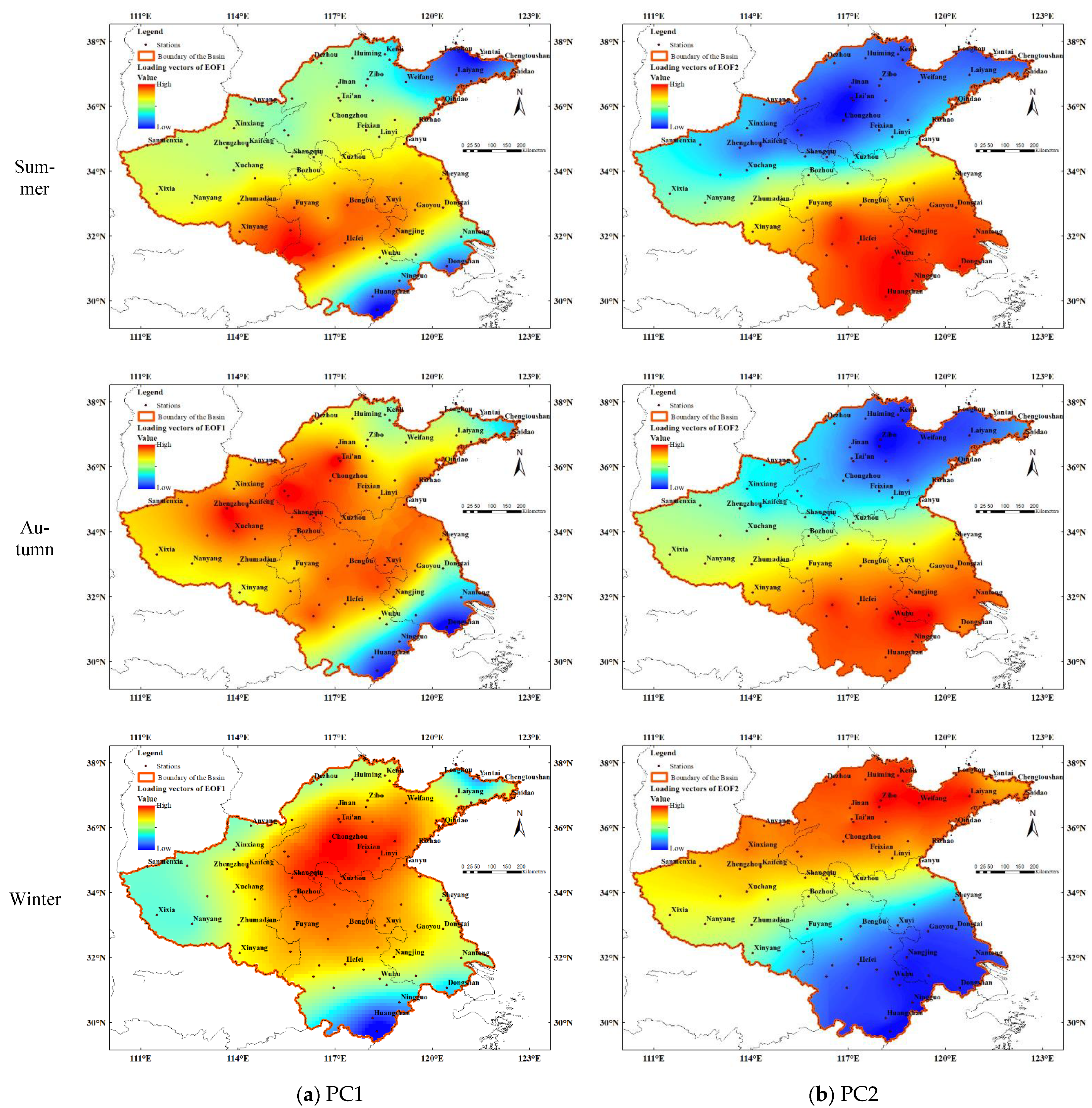
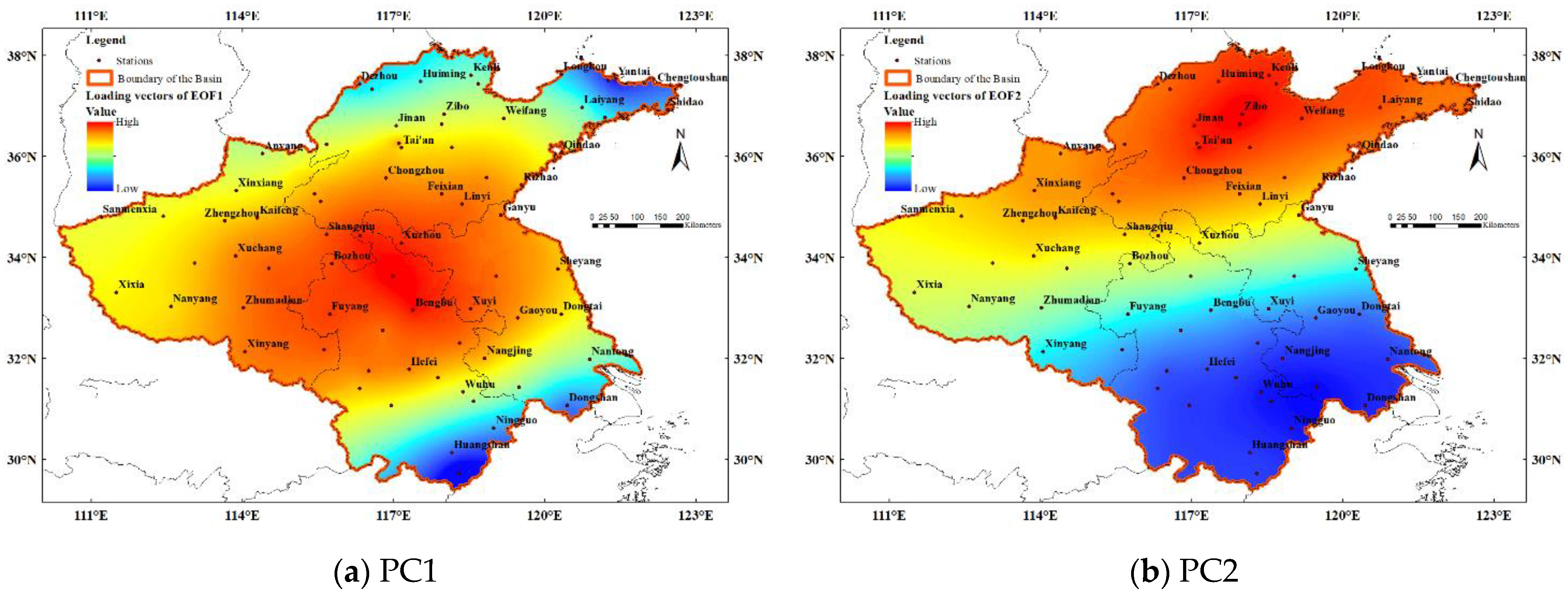
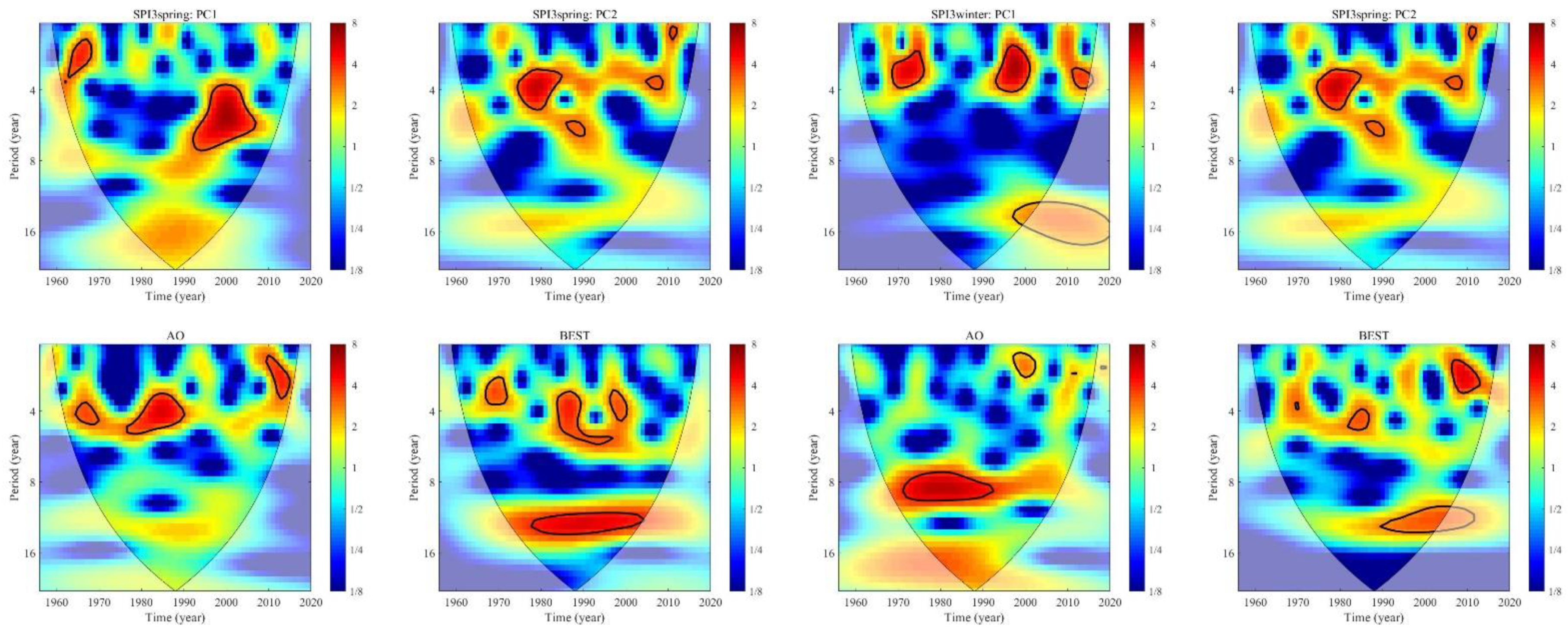
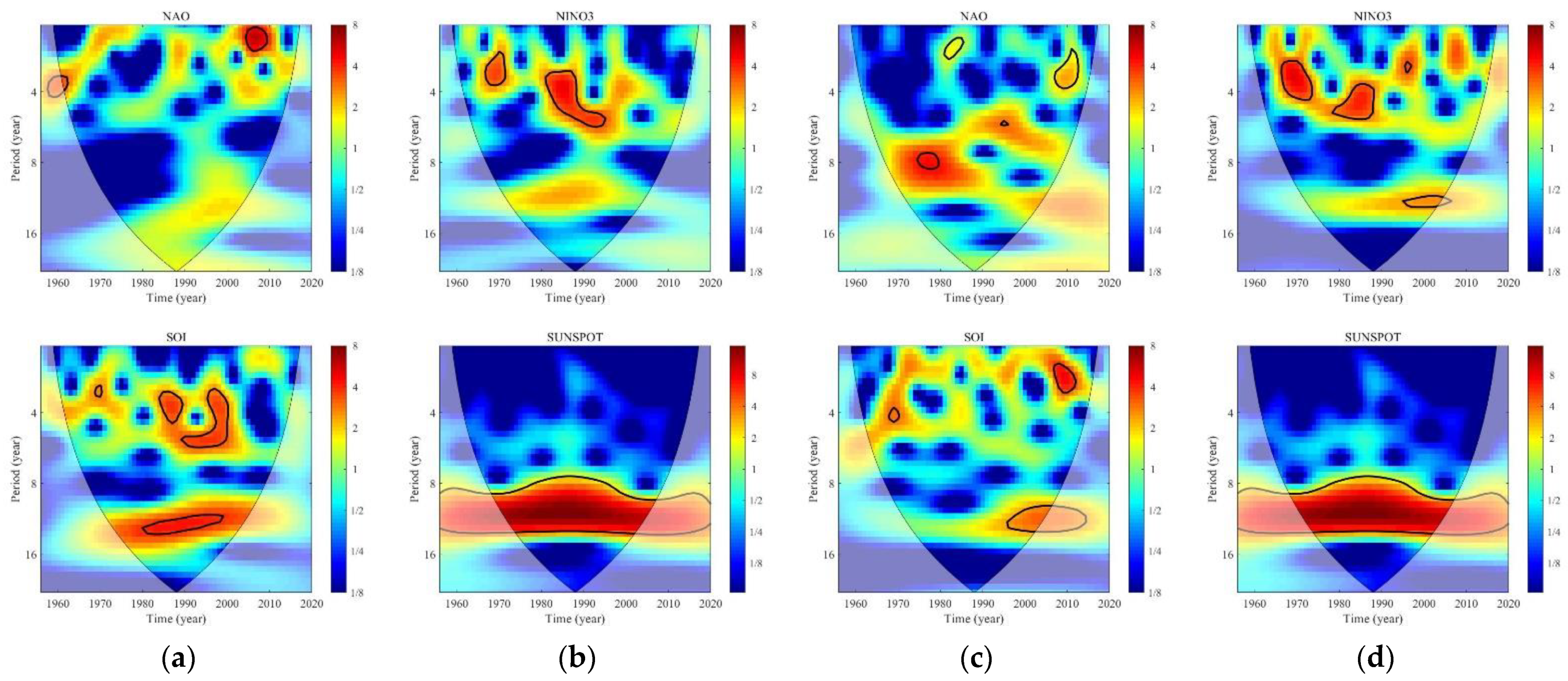

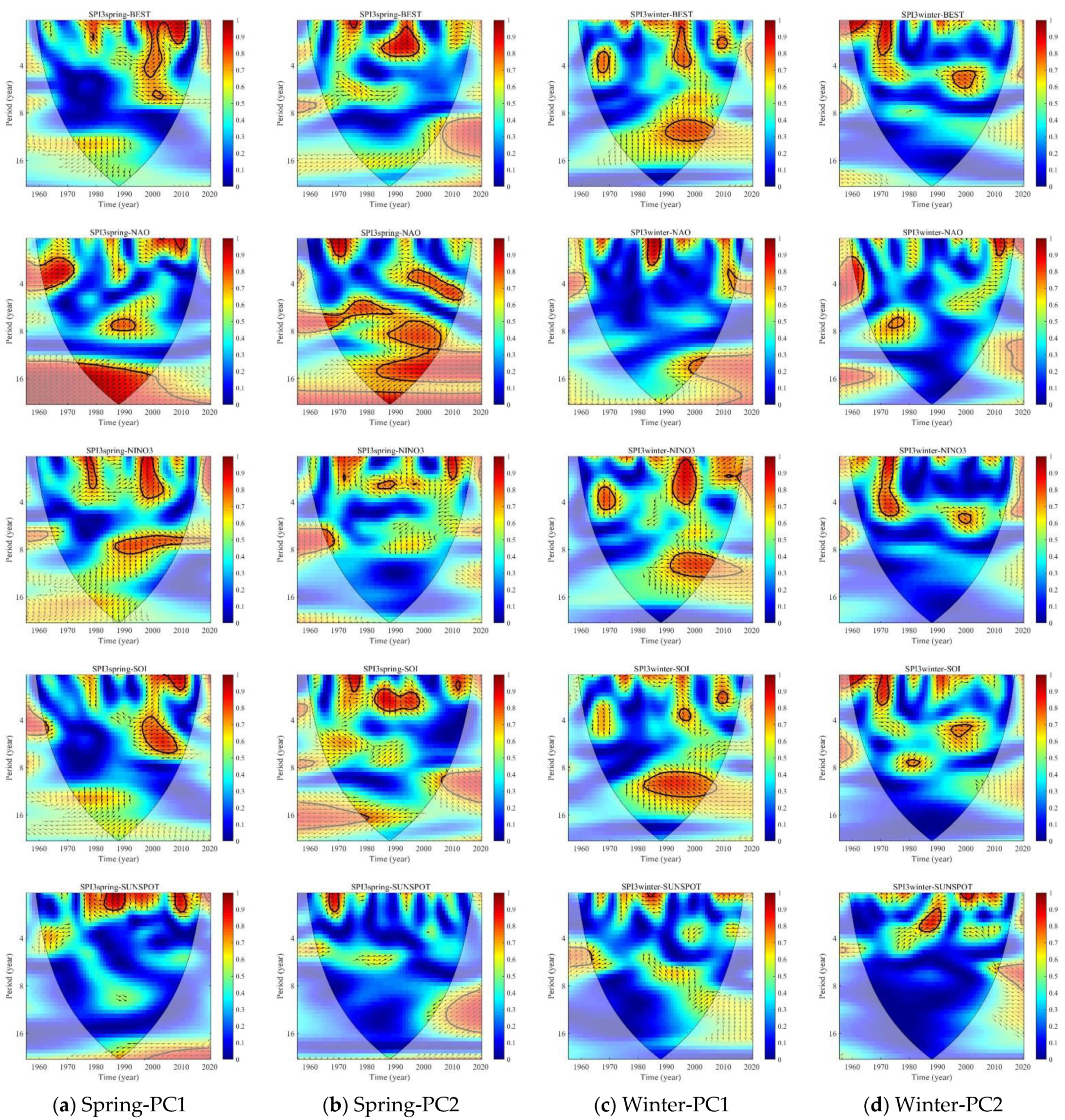
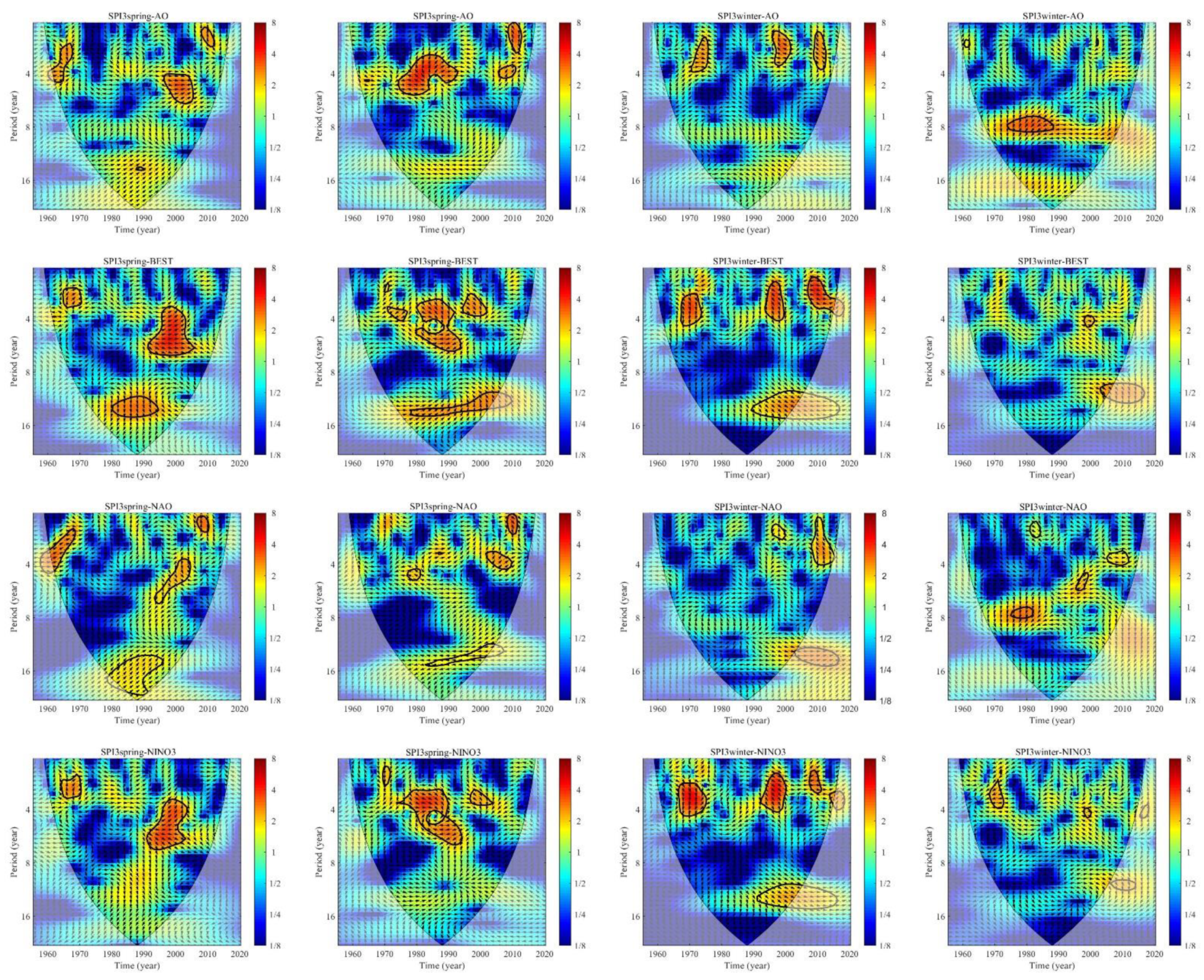

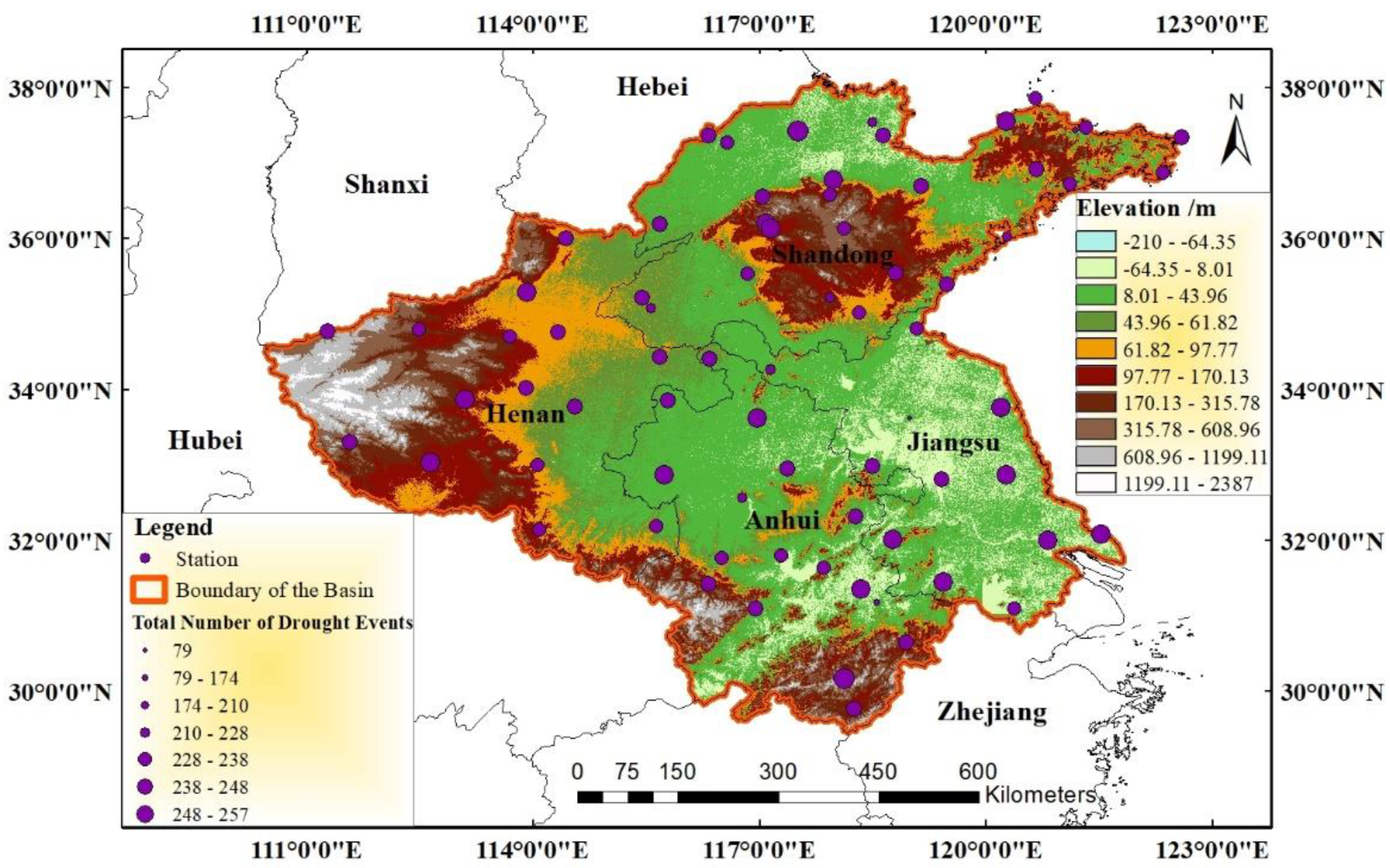
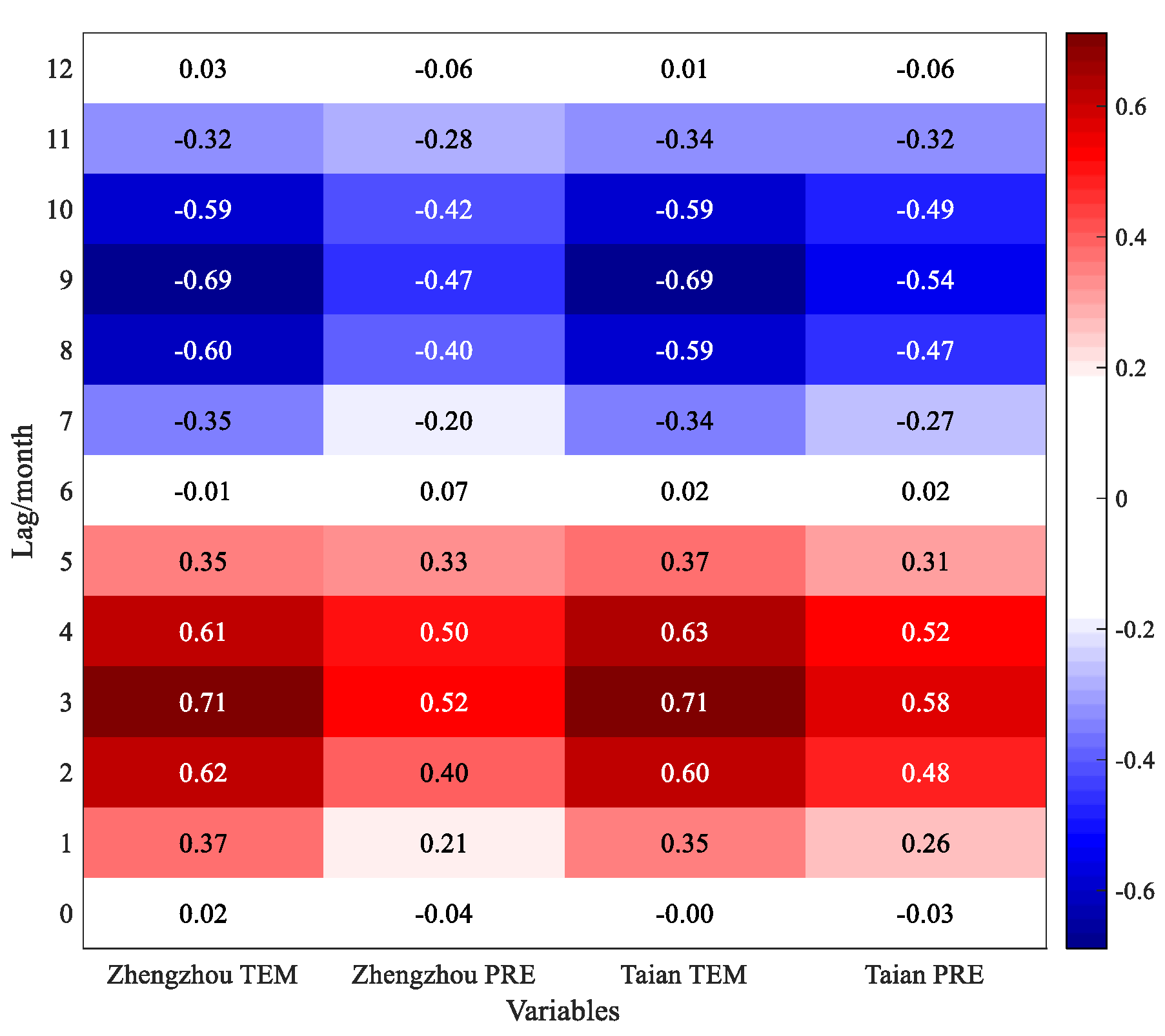

| Season | Mode | Percent Variance Explained (%) | Cumulative Variance (%) |
|---|---|---|---|
| Spring | PC1 | 60.44 | 60.44 |
| PC2 | 12.99 | 73.43 | |
| PC3 | 4.53 | 77.96 | |
| Summer | PC1 | 32.46 | 32.46 |
| PC2 | 16.82 | 49.28 | |
| PC3 | 9.16 | 58.43 | |
| Autumn | PC1 | 37.35 | 37.35 |
| PC2 | 17.32 | 54.67 | |
| PC3 | 10.77 | 65.44 | |
| PC4 | 4.61 | 70.05 | |
| Winter | PC1 | 59.80 | 59.80 |
| PC2 | 14.49 | 74.29 | |
| PC3 | 7.27 | 81.57 | |
| PC4 | 3.46 | 85.03 | |
| SPI-1 | PC1 | 48.88 | 48.88 |
| PC2 | 14.43 | 63.31 | |
| PC3 | 6.86 | 70.17 | |
| PC4 | 3.93 | 74.10 |
Publisher’s Note: MDPI stays neutral with regard to jurisdictional claims in published maps and institutional affiliations. |
© 2021 by the authors. Licensee MDPI, Basel, Switzerland. This article is an open access article distributed under the terms and conditions of the Creative Commons Attribution (CC BY) license (https://creativecommons.org/licenses/by/4.0/).
Share and Cite
Fang, G.; Li, X.; Xu, M.; Wen, X.; Huang, X. Spatiotemporal Variability of Drought and Its Multi-Scale Linkages with Climate Indices in the Huaihe River Basin, Central China and East China. Atmosphere 2021, 12, 1446. https://doi.org/10.3390/atmos12111446
Fang G, Li X, Xu M, Wen X, Huang X. Spatiotemporal Variability of Drought and Its Multi-Scale Linkages with Climate Indices in the Huaihe River Basin, Central China and East China. Atmosphere. 2021; 12(11):1446. https://doi.org/10.3390/atmos12111446
Chicago/Turabian StyleFang, Guohua, Xin Li, Ming Xu, Xin Wen, and Xianfeng Huang. 2021. "Spatiotemporal Variability of Drought and Its Multi-Scale Linkages with Climate Indices in the Huaihe River Basin, Central China and East China" Atmosphere 12, no. 11: 1446. https://doi.org/10.3390/atmos12111446
APA StyleFang, G., Li, X., Xu, M., Wen, X., & Huang, X. (2021). Spatiotemporal Variability of Drought and Its Multi-Scale Linkages with Climate Indices in the Huaihe River Basin, Central China and East China. Atmosphere, 12(11), 1446. https://doi.org/10.3390/atmos12111446






